Number and area of farms/holdings reported in 2012
- The 2012 Census of Agriculture (CA) reported 5.56 million farms/holdings1 covering 7.19 million hectares, which translated to an average area of 1.29 hectares per farm/holding. The number of farms/holdings increased from 1980 to 2012 by 62.6 percent as the average area of farms/holdings decreased from 2.84 hectares per farm/holding in 1980 to 1.29 hectare per farm/holding in 2012. This could be accounted to the partitioning of farms/holdings from one generation of agricultural holders/operators to their succeeding generation.

- Across regions, Region VI – Western Visayas reported the highest number of farms/holdings, 518 thousand farms/holdings with a total area of 460.45 thousand hectares. Region V - Bicol followed next with 486 thousand farms/holdings operated in 765.82 thousand hectares. Region II ranked third with 443 thousand farms/holdings measuring about 478.72 thousand hectares. NCR had the least number of farms/holdings (39 thousand) with an area of 20.27 thousand hectares.
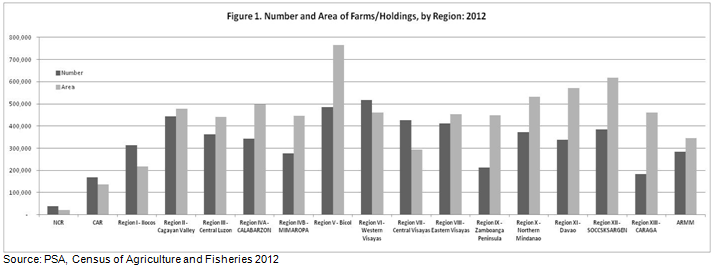
- The top four regions with more than 500 thousand hectares consisted of Region V – Bicol (765.82 thousand hectares), Region XII - SOCCSKSARGEN (618.12 thousand hectares), Region XI - Davao (571.24 thousand hectares) and Region X – Northern Mindanao (532.89 thousand hectares).
- In terms of average area per farm/holding, six regions reported to have more than 1.5 hectare per farm/holding. These were Region XIII – CARAGA (2.515 has./farm/holding), Region IX – Zamboanga Peninsula (2.107 has./farm/holding), Region XI – Davao (1.688 has./farm/holding), Region IVB – MIMAROPA (1.604 has./farm/holding), Region XII – SOCCSKSARGEN (1.603 has./farm/holding) and Region 5 – Bicol (1.575 has./farm/holding).
1 A farm/holding is any piece of land used wholly or partly for any agricultural production involved in raising crops, livestock, poultry and other agricultural activities under single management, and operated as one technical unit by one person alone or with others, regardless of title, legal form, size or location.
2 In the history of jointly undertaking simultaneously the censuses of agriculture and fisheries in the Philippines, the 1980 and 2012 Censuses of Agriculture and Fisheries (CAF) had completely listed and enumerated all households engaged in operating agricultural farms/holdings. The 1991 and 2002 CAF selected and used sample barangays. It listed all households residing in these barangays and interviewed completely those that engaged in any agricultural activities.
More farms/holdings reported area of less than 1 hectare
About 98 percent of the total farms/holdings in the country in 2012 had size of 7 hectares and below. Of these, three in every five farms/holdings were below 1 hectare with an average area of 0.28 hectare per farm/holding. About 32 percent or 1.78 million farms/holdings belonged to farm/holding size group 1.000 hectare to 2.999 hectares. The area of these farms/holdings totalled to 2.59 million hectares with an average of 1.46 hectare per farm/holding. One out of ten farms/holdings belonging to 3.000 hectares – 7.000 hectares had an average area of 4 hectares per farm.
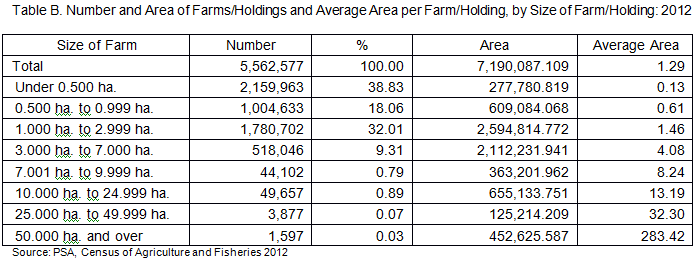
- Two (2) percent of the remaining number of farms/holdings had size of more than 7 hectares, which were categorized as large farms/holdings. These measured to 1.6 million hectares.
About half of the farm/holding parcels were used under temporary crops
- The 5.56 million farms/holdings were reported to have 7.89 million parcels. Seven of the ten farms/holdings consisted only of one parcel3 with a total area of 3.72 million hectares. These farms/holdings had an average area of 0.95 hectare.
3 Parcel is one contiguous piece of land under one form of tenure without regard to land use. It may be surrounded by other lands, water, road, forest or other features that are not part of the holding or part of the holding under different land tenure.
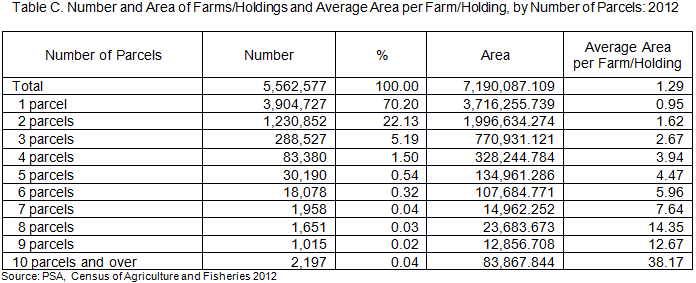
- One-fourth of the total number of farms/holdings had two parcels while the remaining farms/holdings had 3 or more parcels. As the number of parcels per farm/holding increased, the average area per farm/holding also increased.
- About 3.83 million (49 percent) farm/holding parcels with a total measure of 3.44 million hectares were reported to have been used under temporary crops4. Almost one-fourth of the total parcels, covering 3.33 million hectares, were under permanent crops5.
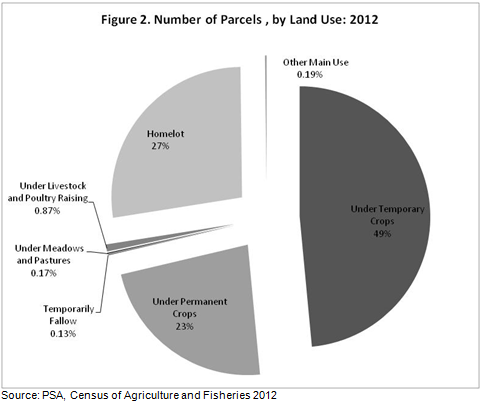
- About 2.2 million homelots were also used in agricultural activities such as raising and keeping livestock and/or poultry, vegetable gardening, etc. Such homelots represented 27 percent of the total parcels used for agricultural operation in 2012. Other parcels were used for raising livestock/poultry, grazing/pasturing, temporarily fallow, etc.
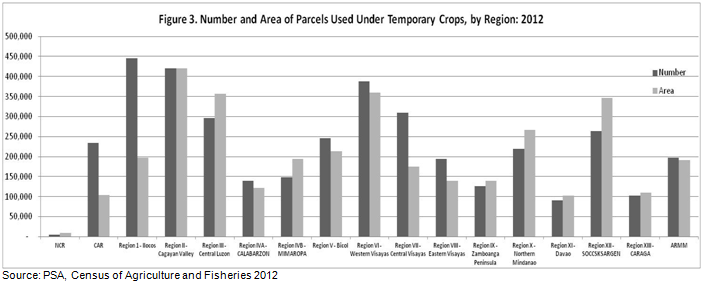

- The top provinces with more than 200 thousand parcels devoted to temporary crops were as follows: (1) Region I – Ilocos (446 thousand); (2) Region II – Cagayan Valley (420 thousand); (3) Region VI – Western Visayas (388 thousand); (4) Region VII – Central Visayas (310 thousand); (5) Region III – Central Luzon (296 thousand); (6) Region XII – SOCCSKSARGEN (263 thousand); (7) Region V – Bicol (247 thousand); (8) CAR (234 thousand); and, (9) Region X – Northern Mindanao (210 thousand).
- Six of the 17 regions reported more than 200 thousand hectares used in growing temporary crops such as (1) Region II – Cagayan Valley with 420 thousand hectares; (2) Region VI – Western Visayas with 359 thousand hectares; (3) Central Luzon with 357 thousand hectares; (4) Region XII – SOCCSKSARGEN with 346 thousand hectares; (5) Region X – Northern Mindanao with 266 thousand hectares; and (6) Region V – Bicol with 214 thousand hectares.
4 Temporary crops (such as palay, corn, etc.) are crops grown seasonally with growing cycle of less than a year and which must be sown/planted again for production after each harvest.
5 Permanent crops (such as fruits trees, etc.) are crops that occupy the land for a period of time and do not need to be replaced after each harvest.
Almost all farms/holdings in the country were household operated
- Ninety-nine percent (or 5.51 million) of the farms/holdings in the country were operated by the households or by individual person. These farms/holdings covered 6.78 million hectares translated into an average area of 1.23 hectares per farm/holding.
- Other farms/holdings were operated by partnership (0.8%), corporation (0.04%), cooperative, government institution, private institution, etc.
Most farms/holdings owned by the agricultural operators
- The land tenure6 of farm/holding reported in 2012 depended on the land tenure of its parcels. Three out of five farms/holdings (3.45 million) in the country were fully-owned or in owner-like possession7 covering 4.34 million hectares. About 15 percent of the farms/ holdings were tenanted (using payment in-kind) with a total area of 1.07 million hectares and about 3 percent were leased/rented (using payment in cash) with 301 thousand hectares. Another 8 percent of the farms/holdings were rented free.
- More or less 706 thousand farms/holdings had combined forms of tenure. These were farms with more than one parcel with different land tenures.
6 Land tenure refers to the right under which a farm/holding parcel is held or operated.
7 Farms/holdings classified under owner-like possession included farms/holdings/holdings held under Certificate of Land Transfer (CLT), Certificate of Land Ownership Award (CLOA), Certificate of Ancestral Domain Title/Certificate of Ancestral Land Title (CADT/CALT), and land under inheritance.
About one out of three parcels used irrigation structure/facility
- About one-third of the total number of farm/holding parcels were provided with water for the crops planted using irrigation structure/facility. The coverage area of these parcels totalled to 1.8 million hectares.
- Three regions stood out in reporting more than 50 percents of their total number of parcels that availed the use of irrigation structure/facility. These were Region 1I – Ilocos in which 68 percent of its total parcels used irrigation structure/facility, Region II – Central Luzon and Cordillera Administrative Region reporting, respectively, 59 percent and 55 percent of its total parcels with irrigation. The other 14 regions reported to have less than 50 percent of their parcels that used irrigation structure/facility.
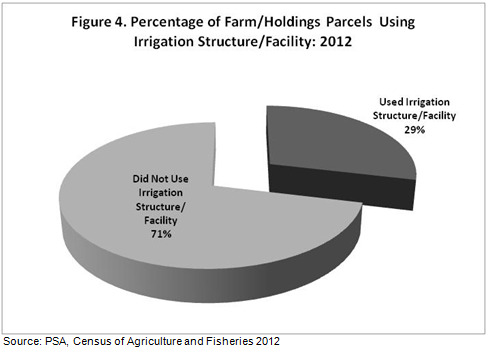
Textual Tables
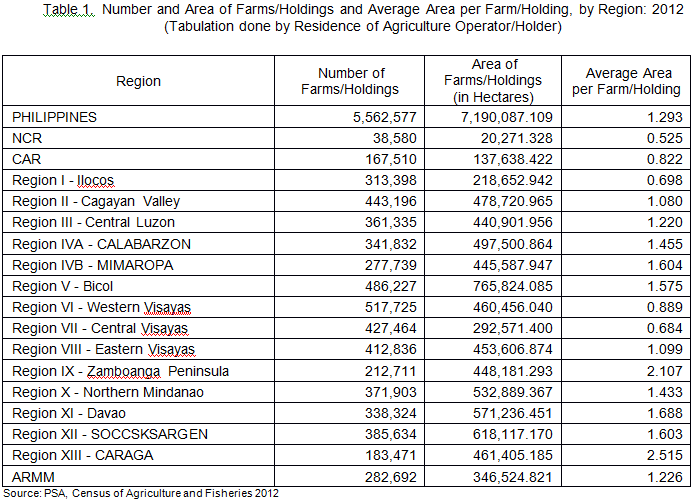
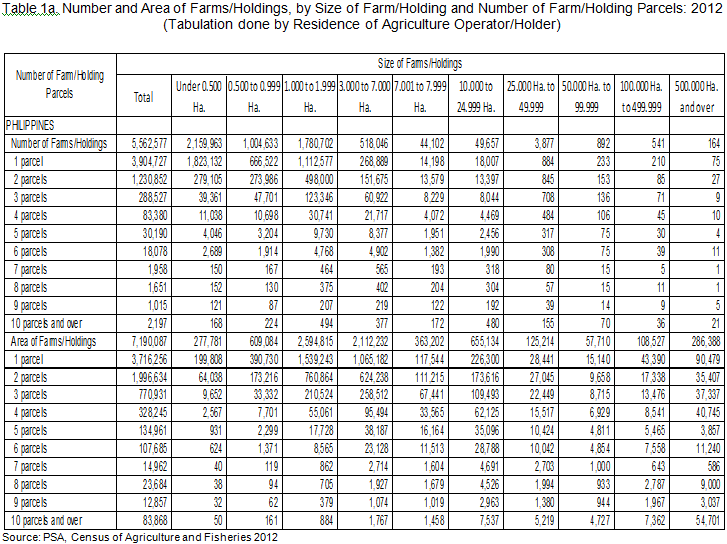
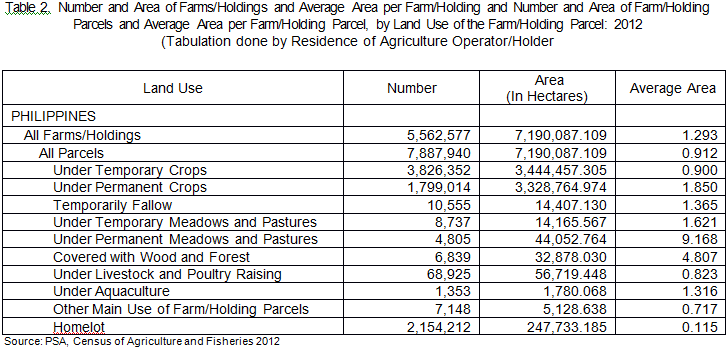

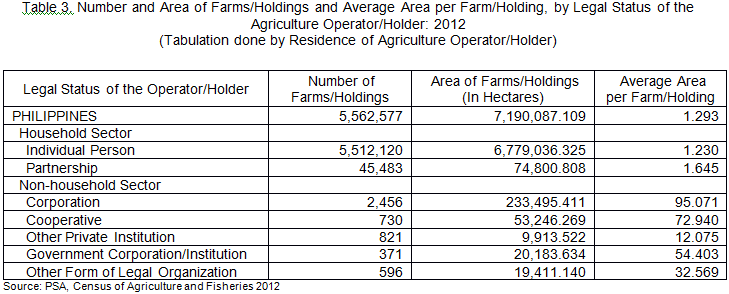
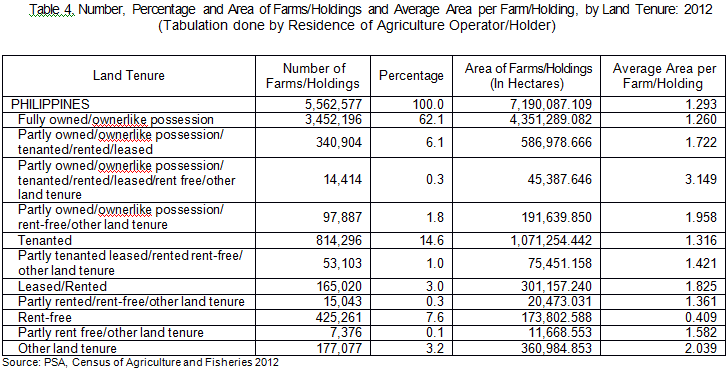
Explanatory Notes
The 2012 Census of Agriculture and Fisheries (CAF) is a large-scale government undertaking geared towards the collection and compilation of basic information on the agricultural and fishery sectors in the Philippines.
Over the years, the CAF has been a source of comprehensive statistics on agriculture and fisheries for the use of the general public, government, business industry, and research and academic institutions
The reference period of the 2012 CAF was from January 1, 2012 to December 31, 2012. Note that the municipalities of Banganga, Boston and Cateel in Davao Oriental were not covered during the 2012 CAF enumeration because typhoon Pablo devastated these areas.
This special report is first of the series for 2012 CAF. The data were tabulated according to the geographic area of the residence of agriculture operators, which may not be the same as the actual location of the farm/holding or farm/holding parcels.
LISA GRACE S. BERSALES
Undersecretary
National Statistician and Civil Registrar General
